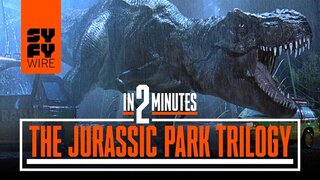Create a free profile to get unlimited access to exclusive videos, sweepstakes, and more!
Jurassic Park III's Aviary Scene Is One of the Franchise's Best
Pteranodons in the mist...
Perhaps it’s fitting that the oldest Jurassic Park movie — a franchise about ancient, formerly long-extinct dinosaurs — is still the best one. Sure the sequels and the follow-up Jurassic World trilogy have their thrills and charms, but nothing can top the original. Yet, there are specific sequences in the other movies that fit right in.
Jurassic Park III (now streaming on Peacock!) is widely regarded as one of the weaker entries in the franchise, but “the birdcage” scene is a series highlight, one that serves as a dark echo of the first time Alan Grant (Sam Neil) saw a dinosaur. Then, it was something he (and the audience) had never seen, and it was awe-inspiring. In Jurassic Park III, it’s horrifying.
RELATED: Stream the Original Jurassic Park Trilogy on Peacock For Franchise's 30th Anniversary
The film brings Dr. Grant back to Isla Sorna. He’s been lured there under false pretenses, as Paul and Amanda Kirby (William H. Macy and Téa Leoni) are not actually wealthy would-be funders of Grant’s raptor research but instead a middle-class divorced couple trying to rescue their son, Eric (Trevor Morgan), who went missing on the island while parasailing weeks earlier. When a Spinosaurus — a dinosaur who the movie positions a little too obviously as a bigger and badder T. rex counterpart — attacks, they’re stranded; though they discover that Eric has indeed survived. Together, they attempt to make their way across Isla Sorna to safety.
Why the "Birdcage" Scene in Jurassic Park III Is One of the Franchise's Scariest Moments
At one point, they enter some kind of giant cage nestled amongst cliffs and shrouded in fog. Eric, momentarily separated once more from his parents and Grant, ventures out onto a bridge, the end of which cannot be seen in the thick white fog. A shape appears at the end of the bridge, and at first, Eric mistakes it for his parents. Meanwhile, Grant has the horrible realization of where they are — the aviary. And what would Jurassic Park have instead of birds in its aviary? Pteranodons.
These long-extinct flying reptiles (which are technically not dinosaurs but are frequently lumped in with them in popular culture) were surprisingly huge. When they “walked,” wings folded up, they resembled less birds and more terrifying, pointy giraffes in miniature. (The Pteranodon towers over Eric; an even bigger flying reptile, Quetzalcoatlus, as seen in Jurassic World Dominion, was taller than an actual giraffe.)
RELATED: Coolest dinosaur attacks in the Jurassic Park & Jurassic World franchise
In part because they are not actually dinosaurs, the Pteranodons have a vibe unlike anything we’d previously seen in a Jurassic Park movie. It’s because of this, and the eerie, atmospheric (literally) way in which they’re introduced, that the Pteranodon’s reveal echoes the reveal of the Brachiosaurus — the first dinosaur that Grant (and the audience) saw in full back in the first Jurassic Park. But, where that scene was played for awe, with John Williams’ sweeping score reflecting the majesty of these beasts, Jurassic Park III’s winged counterpart plays for horror. Once more, we’re seeing an extinct creature the likes of which we haven’t seen before. But, rather than a gentle giant in broad daylight, what we have here is a pointy predator that emerges from the mist.
The rest of the aviary scene, once the mayhem begins and everybody starts trying to escape from the Pteranodons’ cage before they’re picked up and plopped in a nest full of hungry babies, is fun, but it doesn’t quite match the height of that initial reveal. So much of what makes the Jurassic Park franchise work is about mood more than it’s about dinosaur action (though dinosaur action is an integral part of the series). Jurassic Park is at its best when it treats the reveal of these creatures — animals that once graced the face of the Earth but whose existence is now limited to history and fiction — as momentous occasions. We feel what Grant feels, gazing up at the Brachiosaurus. And, though it can’t match the heights of the original, when the Pteranodon emerges from the mist, we’re doing more than just watching. We’re feeling something.
Jurassic Park III is now streaming on Peacock, alongside the original, which is currently celebrating its 30th anniversary.






























